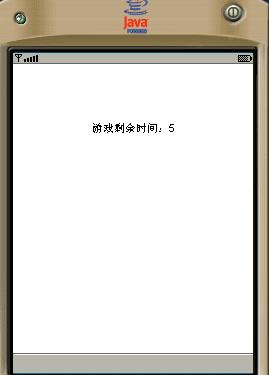|
在java.util包中有一个TimerTask类,你可以扩展这个类并且实现他的run()方法,在run()方法中编写我们的逻辑代码。如果我们想制作一个游戏时钟,那么非常简单我们编写一个GameClock类扩展TimerTask,GameClock需要维持一个实例变量timeLeft,这样我们就可以记录游戏剩余的时间了,在每次run()运行的时候把timeLeft减1就可以了。有时候我们需要始终暂停以及重新启动,这并不复杂,在GameClock中添加一个boolean类型的标记就可以了。下面给出GameClock的代码:
/*
* GameClock.java
*
* Created on 2005年7月18日, 上午11:00
*
* To change this template, choose Tools | Options and locate the template under
* the Source Creation and Management node. Right-click the template and choose
* Open. You can then make changes to the template in the Source Editor.
*/ package com.j2medev.gameclock;
import java.util.TimerTask;
/**
*
* @author Administrator
*/
public class GameClock extends TimerTask{
private int timeLeft = 60;//时钟的默认时间
private boolean pause = false;
/** Creates a new instance of GameClock */
public GameClock() {
}
public GameClock(int value){
timeLeft = value;
}
public void run(){
if(!pause){
timeLeft--;
}
}
public void pause(){
pause = true;
}
public void resume(){
pause = false;
}
public int getTimeLeft(){
return timeLeft;
}
public void setTimeLeft(int _value){
this.timeLeft = _value;
}
} 当我们使用这个时钟的时候,只需要把它的一个实例作为参数传给Timer的schedule()方法即可。例如
clock = new GameClock(30);
timer.schedule(clock,0,1000); 接下来我们编写一个简单的游戏界面测试一下时钟。我们在程序启动的时候开始计时,每隔一秒钟timeLeft会减少1,并且在手机屏幕上显示当前剩余的时间。如果timeLeft为0的时候代表游戏已经结束了。因此我们需要这样判断游戏的状态。
public void verifyGameState(){
timeLeft = clock.getTimeLeft();
if(timeLeft == 0){
going = false;
}
}
为了测试时钟的暂停功能,我们接收用户的按键行为,如果左键被按下,那么调用clock的pause()方法,如果右键被按下则调用clock的resume()方法。
public void userInput(){
int keyStates = this.getKeyStates();
if((keyStates & GameCanvas.LEFT_PRESSED) != 0){
clock.pause();
}else if((keyStates & GameCanvas.RIGHT_PRESSED) != 0){
clock.resume();
}
} 下面给出MIDlet和Canvas的代码:
/*
* ClockCanvas.java
*
* Created on 2005年7月18日, 上午11:04
*
* To change this template, choose Tools | Options and locate the template under
* the Source Creation and Management node. Right-click the template and choose
* Open. You can then make changes to the template in the Source Editor.
*/ package com.j2medev.gameclock;
import java.util.Timer;
import javax.microedition.lcdui.Command;
import javax.microedition.lcdui.Graphics;
import javax.microedition.lcdui.game.*; /**
*
* @author Administrator
*/
public class ClockCanvas extends GameCanvas implements Runnable {
private Timer timer = new Timer();
private GameClock clock = null;
private boolean going = true;
int timeLeft = 0;
/** Creates a new instance of ClockCanvas */
public ClockCanvas() {
super(false);
}
public void run(){
clock = new GameClock(30);
timer.schedule(clock,0,1000);
while(going){
verifyGameState();
userInput();
repaint();
try{
Thread.sleep(100);
}catch(Exception e){
e.printStackTrace();
}
}
}
public void userInput(){
int keyStates = this.getKeyStates();
if((keyStates & GameCanvas.LEFT_PRESSED) != 0){
clock.pause();
}else if((keyStates & GameCanvas.RIGHT_PRESSED) != 0){
clock.resume();
}
}
public void paint(Graphics g){
int color = g.getColor();
g.setColor(0xffffff);
g.fillRect(0,0, this.getWidth(), this.getHeight());
g.setColor(color);
if(timeLeft == 0){
g.drawString("游戏结束", this.getWidth()/2, this.getHeight()/4, Graphics.HCENTER|Graphics.BOTTOM);
}else{
g.drawString("游戏剩余时间:"+timeLeft, this.getWidth()/2, this.getHeight()/4, Graphics.HCENTER|Graphics.BOTTOM);
}
}
public void verifyGameState(){
timeLeft = clock.getTimeLeft();
if(timeLeft == 0){
going = false;
}
}
public void start(){
Thread t = new Thread(this);
t.start();
}
public void stop(){
going = false;
}
}
/*
* TestMidlet.java
*
* Created on 2005年7月18日, 上午11:00
*/ package com.j2medev.gameclock; import javax.microedition.midlet.*;
import javax.microedition.lcdui.*; /**
*
* @author Administrator
* @version
*/
public class TestMidlet extends MIDlet {
private Display display = null;
public void startApp() {
display = Display.getDisplay(this);
ClockCanvas canvas = new ClockCanvas();
canvas.start();
display.setCurrent(canvas);
}
public void pauseApp() {
}
public void destroyApp(boolean unconditional) {
}
}
程序运行的截图如下:
 总结:本文实现了一个游戏开发中可能用到的时钟程序,代码并不复杂。希望能对大家有所帮助。
| 
